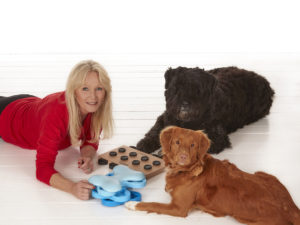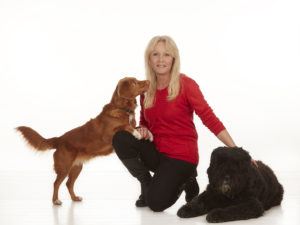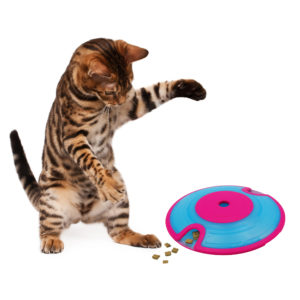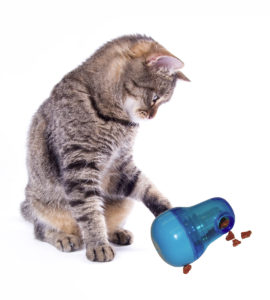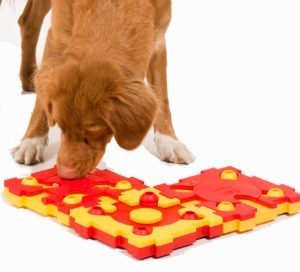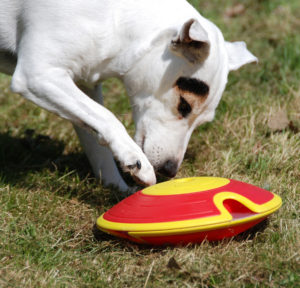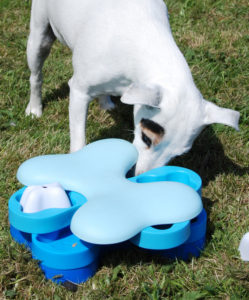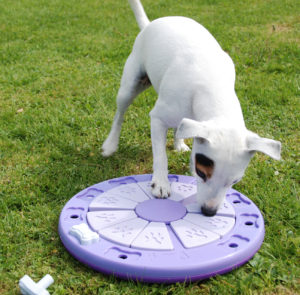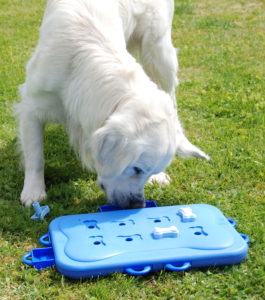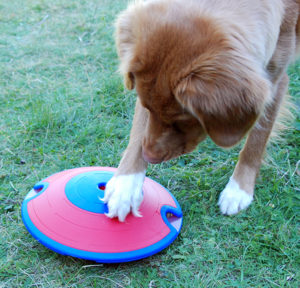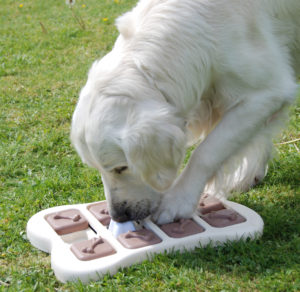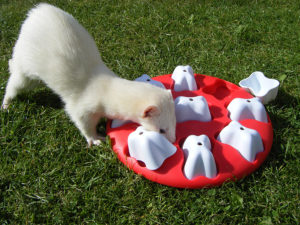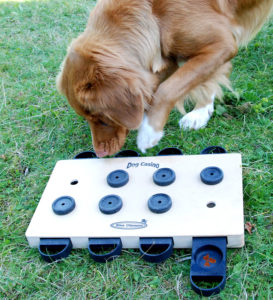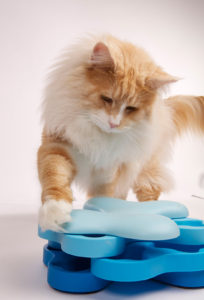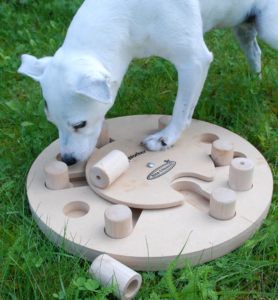Nina Ottosson is a pet toy designer who is hailed by dog psychologists and trainers around the world as being one of the best at development and design of educational activity puzzle games for dogs and other animals. Nina pioneered this category of pet products more than 20 years ago and each item is carefully developed by Nina together with dogs, using only the best materials for optimal function and safety for the dogs as well as the environment. In 2015 she won the Pet Age Women of Influence Award, and was also named one of “45 people who changed the dog world” by Dog Fancy Magazine.
Nina has always had dogs, cats, and other animals, and she had two Bouvier des Flandres (her favorite breed) that she used to train and compete with. But when her two children were born a year and a half apart, Nina did not have time to activate her dogs the way that they were used to. Nina’s guilty conscience made her start thinking about how to activate her dogs in a simple, fun and varied way indoors, together with the kids.
Since 1990 she has worked with development and design of dog activity toys and games that stimulate the dog mentally. The games are fun and educational, easy to play with indoors or outdoors, and are developed with the dog’s natural movements and instincts in mind. They are designed for the dog to work with problem solving by finding hidden treats/food in different ways. Nina calls them “games” because the owner and the dog are supposed to play together, which strengthens the bond between them. They can be used by dogs of all ages, sizes and breeds, and also by cats, ferrets, parrots and lots of other animals.
Nina’s philosophy is that dogs have four legs and a brain, and all five need to be stimulated and activated. All dogs as well as other pets need to use their brain in order to keep healthy. Some dogs need more brain activity than others. If dogs are not provided with an outlet for their energy in the form of different types of activity or other stimulation, they can sometimes find their own “activity” which we as dog-owners often do not appreciate, like chewing, becoming aggressive or just generally hyperactive. Products like my puzzle games and toys can help dogs to not be a problem dog.
Nina is careful to only use the best materials; the plastic games and toys are splinter-free and non-toxic, and have been FDA tested and approved for food. The wooden games are made of certified “SVANEN” marked eco-friendly Carb 2 MDF, which means that no formaldehyde is added, which is very common for similar products. Her products are developed with dogs and for dogs – not by a computer since dogs have different levels of intelligence and different items will appeal to different canines.
Nina realized from the beginning, especially after having tested these games on different dogs, that her games must have different levels of difficulty to fit as many dogs as possible. Some dogs are happy with games that are simple and easy, while others need increasingly difficult ones. It’s the same for humans and crossword puzzles, some people are happy with the simple ones, while others continue to challenge themselves with ones that are more and more difficult. Some people wonder if the dogs get tired of the games so Nina compares them to playing games like Monopoly – everyone knows how to play it but it’s still exciting and fun to play, and the same is true for dogs and these games.
Nina’s pet games are excellent to use for dogs that are injured as well as senior dogs. She has a lot of experience with older dogs that were not able to go for walks due to worn-out hips and joints. Despite this, they were very alert because she played games with them daily and is convinced that their final years were enriched because of this. When her dogs were injured she placed the games on a chair or in her lap, so they have to work with the nose and not with their injured paw. It can be very challenging to keep an injured dog still for several weeks, but the games are a great activity that lets the dog get an outlet for all its energy. They are also great for dogs that are overweight since they have to work for the food and as well underweight dogs, many dogs will eat more when the food is put in the games instead of the bowl.
Nina’s overall mission is for dogs and their owners around the world to have fun with her products! Recently, she spoke to the Examiner about her experiences working as a pet toy designer and her hopes for the future:
Meagan Meehan (M.M.): How did you get interested in toy design, especially toy designs for pets?
Nina Ottosson (N.O.): I used to work in health care at the hospital. When my two kids were born a year and a half apart, I did not have time to activate my dogs the way they and I were used to. In 1990 I started working with development and design of dog activity toys and games that stimulate the dog mentally, or “brainteasers” for dogs. The toys are fun and creative, easy to play with indoors or outdoors, and are developed with the dog’s natural movements and instincts in mind.
M.M.: As a child, what were your favorite toys? Do you think they impacted the kinds of things you now design?
N.O.: I didn’t have any favorite toy that I can remember, but since I was born I have been interested of dogs and other pets as well. As a child I played a lot with all our pets, we had dogs, cats, birds, guinea-pigs, hamsters, and rabbits, and for some years when I was young I was a horse girl. So my specific interest in dogs is the reason why I started develop puzzles which stimulate the dogs mentally, by problem solving and searching for treats and food.
M.M.: Generally, what is your product design process like? For example, do you use any special tools or programs?
N.O.: The process can vary depending on how complex the product is, but it always starts with an idea in my head, that I then sketch manually onto paper. The next step is to make a variety of prototypes of certain details that I want to test with my dogs. When I have the correct construction and function, 3D drawings are made, and from these I make a prototype to test on different dogs. The last step is an injection mold tool to make the finished product (in plastic).
M.M.: What have been the most interesting and/or rewarding parts of making toys?
N.O.: I am very proud of the fact that I created the category of ”Dog Treat Puzzle Games and Toys” worldwide, and I know that I have helped a lot of dogs and their owners understand that mental activation is very important for a dog, so he can channel his energy and function better every day. Dogs are much smarter than most people think, most of them love to have a ”job”.
M.M.: What kinds of behaviors do you hope pets achieve by using your products?
N.O.: It is not always easy to find the time – or ideas – to activate your dog, and people may not realize how important it is for the dog’s overall health. It would significantly reduce the number of “problem dogs” if everyone understood how important it is for the dog to use both its head as well as its legs. Our dogs need mental activation as much as daily walks. I always tell people: “A dog has four legs and one brain and all five need activity, but in different ways”. My products, the Nina Ottosson Puzzle Toys and Games, which most dogs love to play with, are designed for the dog to work with problem solving in different ways, by finding hidden treats or food by: lifting blocks, turning discs, pushing blocks, putting blocks inside something etc. My puzzle games are available in all levels of difficulty to suit dogs and other pets, of all ages, sizes and breeds. However, dogs have different levels of intelligence just like us humans. I realized from the beginning that my puzzle games must have different levels of difficulty to fit as many dogs as possible. In addition, some dogs with a genetic disposition for fetching will find certain games easier than dogs that first have to learn how to fetch. All dogs enjoy a variety of activities and appreciate trying new things. The same goes for these games – some dogs are happy with games that are simple and easy, while others need increasingly difficult ones. It’s the same for us humans and crossword puzzles, some people are happy with the simple ones, while others continue to challenge themselves with ones that are more and more difficult.
M.M.: You designed toys for dogs and cats. What are the major differences between designing for those species?
N.O.: A lot of cats use the same puzzles as dogs, but I have some only for cats, because some designs need to be smaller so the cat can handle it. Also, cats are more visual than dogs; they like to be able to see the treats or food, so some of my cat products are more transparent than the dog products
M.M.: Birds like parrots and many zoo animals also benefit from enrichment activities and toys. Do you design for other kinds of animals?
N.O.: My expertise is dogs and cats and I have focused on this category, but I have been testing products on parrots, ferrets and zoo animals as well like monkeys, wild cats, lizards, etc., all animals can use puzzle games and toys.
M.M.: What are your career aspirations over the next ten years?
N.O.: My company was recently acquired by Outward Hound in the US and in the future I will focus on new product development, which I really love to do and look forward to.
M.M.: What advice would you give to someone who is aspiring to enter the toy or game design industry, especially for pets?
N.O.: Knowledge about pets, manufacturing, and sales strategy is important.
M.M.: Are you currently working on any projects that you would like to mention?
N.O.: I am always working on new projects, and next year we will launch new exciting products, read more about them on our websites!
* * * * *
To learn more, visit Nina Ottosson’s official website or see here.
